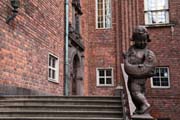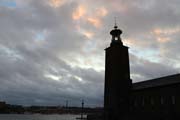Situated in Northern Europe, Sweden lies west of the Baltic Sea and Gulf of
Bothnia, providing a long coastline, and forms the eastern part of
the Scandinavian Peninsula. Stockholm is the capital and most populous
urban area of Sweden (approximately 1.6 million in the urban area, and 2.4
million in the metropolitan area). The city stretches across fourteen
islands where Lake Mälaren flows into the Baltic Sea. Stockholm has an oceanic
climate with humid continental influences, and it has relatively mild weather
compared to other locations at a similar latitude, or even farther south.
Due to the city's high northerly latitude, the length of the day varies widely
from more than 18 hours around midsummer to only around 6 hours in late
December.
Getting there ...
We were visiting Linus in Boston
during Christmas, and we continued our winter vacation together from Boston.
We had separate flights on 12/26 night (Linus and Miriam was on Lufthansa via
Munich, while we were on SWISS Air via Zurich) and re-grouped at Stockholm
Arlanda Airport in the late afternoon on 12/27. Linus' flight was
scheduled to arrive about 30 minutes earlier than us. But their flight got
delayed in Munich and became one hour later than ours. We stayed in
Stockholm for 4 nights and then continued to Kiruna for
another 4 nights.
[Sweden Part I: Stockholm] [Sweden Part II:
Kiruna]
12/28 (Day 2) ...
- Sunrise
I walked from our hotel across the bridge to the opposite
side of the old town to a hill called Mariaberget. It offers sweeping
city views in a gorgeous sunrise morning.
- Royal Palace (Kungliga slottet)
Located in the old town (Gamla stan)
of Stockholm, Kungliga slottet is the official residence and major royal
palace of the Swedish monarch (the actual residence of the current King and
Queen is at Drottningholm Palace). The first building on this site was
a fortress with a core tower built in the 13th century by Birger Jarl to
defend Lake Mälaren. The fortress grew to a castle, eventually named Tre
Kronor for the core tower's spire top decorated with three crowns.
During the Great Power period, after the Westphalian Peace in 1648, the
ambition of the castle grew and radical rebuilds were planned. However, none
of this came to fruition until 1692 that these works were started under the
leadership of the castle architect Nicodemus Tessin, the younger castle's
northern length of the Baroque style contrasting with the rest of
the Renaissance castle.
On May 7, 1697, a devastating fire
erupted, largely destroying most of the old castle, but the Tessin newly
rebuilt northern elongation managed to survive fairly unscathed. Six
weeks after the fire disaster, Tessin presented drawings to the new castle
for the Swedish government. According to plans, the new castle would be
erected in about six years. In reality, the royal family could only relocate
to the castle in December 1754, that is, for the next sixty years after the
fire.
Linus did not feel well and had a fever this morning. So we
let him stay in the hotel to take a rest, and the rest of us went on for our
plan to visit the Royal Palace and the Old Town (Gamla stan).
- Old Town (Gamla stan)
The town dates back to the 13th century,
and consists of medieval alleyways, cobbled streets, and archaic
architecture with strong North German architecture influence. In
addition to the Royal Palace (Kungliga slottet), Gamla stan is also home to
the Stockholm Cathedral (Storkyrkan), the Nobel Museum, and the Riddarholm
church (Riddarholmskyrkan).
We walked through several cobbled
streets and alleys including
Prästgatan and
Mårten Trotzigs gränd
(claimed to be the narrowest street in Stockholm), and visited a special
sculpture
Järnpojke ("Iron Boy"), a cute tiny sculpture (only 15cm high!) by
the Swedish artist Liss Eriksson. It was created in 1954 and moved to
the current location in 1967.
- Stockholm Cathedral (Storkyrkan)
Linus was getting better and he
walked to the Old Town to meet with us at the Stockholm Cathedral at about
3PM.
Stockholm Cathedral (Storkyrkan, "the Great Church") is the oldest
church in Gamla stan. Dated back to the 13th century, the
Cathedral has been at the heart of religious and political life in Sweden.
It has had its present shape and size since 1480, when it was extended to a
five-aisled hall church in the Nordic brick Gothic style. The Storkyrkan
received its current baroque appearance in the middle of the 17th century in
order to harmonize stylistically with the recently built castle/palace.
- Nobel Museum
The Nobel
Museum opened in the spring of 2001 for the 100th anniversary of the Nobel
Prize. The museum illustrates a century of creativity, where visitors
can follow the changes of the 20th century through the Nobel Prize and the
Nobel Laureates.
- Gamla stan at night
Technically it was not at night yet; it was only
4:15PM!
12/29 (Day 3) ...
- Skansen
Skansen is the
world’s oldest open-air museum, showcasing the whole of Sweden with houses
and farmsteads from every part of the country. It was opened on 11
October 1891 by Artur Hazelius (1833–1901) as a part of the Nordic Museum,
but became an independent organization in 1963. After extensive
travelling, Hazelius bought around 150 houses from all over the country (as
well as one structure from Norway) and had them shipped piece by piece to
the museum, where they were rebuilt to provide a unique picture of
traditional Sweden. There is also an open-air zoo containing a
wide range of Scandinavian animals including the bison, brown
bear, moose, grey seal, lynx, otter, reindeer, wolf, and wolverine.
- Vasa Museum
Vasa was a
Swedish warship built between 1626 and 1628. The 64-gun
warship Vasa sank on her maiden voyage after sailing about 1,300 m on 10
August, 1628. She was located again in the late 1950s in a busy
shipping lane just outside Stockholm harbor. The ship was salvaged with a
largely intact hull in 1961. After 333 years on the sea bed the mighty
warship was salvaged and the voyage could continue.
Today Vasa is the
world's best preserved 17th century ship and the most visited museum in
Scandinavia. I think it is quite an ironic story that a big failure
and embarrassment in the old time becomes one of the most popular
attractions nowadays.
12/30 (Day 4) ...
-
Winter Boat Tour (Stromkajen)
Aboard the classic archipelago vessel, MS Angantyr (it celebrated 100 years
in 2009), the boat tour took us along the city quaysides and out to
Fjäderholmarna, Stockholm's closest archipelago island, which we sailed
around before returning to the city. During the trip, we passed many
magnificent contemporary and historic buildings, as well as beautiful nature
on Royal Djurgården. I went to the
upper deck on the half
way and found a spot just behind the bridge that blocked most of the wind so
I could stay in the open air without freezing.
- Stockholm Subway Stations
My original plan was to visit the National
Museum after the boat tour. However, the museum was not open on
Mondays so I decided to go for my backup plan: visiting the arts under
Stockholm. The Stockholm subway system is said to be the world's
longest art exhibit - 110 kilometers long. Traveling by subway is like
traveling through an exciting story that extends from the artistic pioneers
of the 1950s to the art experiments of today. Over 90 of the 100 subway
stations in Stockholm have been decorated with sculptures, mosaics,
paintings, installations, engravings, and reliefs by over 150 artists.
With a single ride ticket (45SEK ~ US$4.8 for 2 hours), we visited
Kungsträdgården,
T-Centralen,
Tekniska
Högskolan, Stadion,
and Solna Centrum
Stations. It was a well spent 2-hour $4.8 art tour!
- City Hall (Stadshuset)
Stockholm City Hall (Stadshuset) is one of
Sweden's most famous buildings. Under its roof many different businesses are
merged. It is a workplace and political office building, one of the
country's premier party venues (including the Nobel Prize banquet) and a
popular tourist destination. In 1907 the city council decided to
build a new city hall as Stockholm expanded greatly and it became evident
that the city needed more and larger premises for its various operations.
The construction took twelve years, from 1911 to 1923, and nearly eight
million red bricks were used. Stadshuset is considered one of Sweden's
foremost examples of national romanticism in architecture.
 |
 |
|
|
- Nutcracker
After an early dinner, we walked to the Royal Swedish
Opera (Kungliga Operan) for a Christmas seasonal celebration: Nutcracker.
The Royal Opera is Sweden's national stage for opera and ballet. It has been
the theater since January 18, 1773 when the first performance was given for
King Gustav III. The new opera house was inaugurated by Oscar II on
September 19, 1898 after 7 years of construction. In 1989, after
almost 100 years of well-used opera building, the Opera underwent a major
renovation to restore its original splendor.
12/31 (Day 5) ...
We concluded our Stockholm vacation with different routes: Linus and
Miriam will fly back to Boston later today, and Woanyu, Iris, and I will go
further north to Kiruna (90 miles within Arctic circle) to continue our 2nd part
of Sweden tour [Sweden Part II: Kiruna]; the real
winter adventure began!
[Back to Photo Page]
[Sweden Gallery]